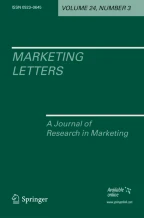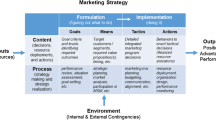The past, present, and future of marketing strategy

This article provides a high-level overview of marketing strategy research and offers a number of suggestions of areas ripe for future research. We discuss the most fundamental concepts that continue to drive current marketing strategy research and examine how these concepts have shaped marketing strategy and the role of the marketing function. In addition, we highlight the developments in marketing accountability, marketing’s influence within the firm, and alternatives to a market-driven approach in generating sustainable competitive advantage. Finally, we identify directions for future research in the light of recent developments, availability of new data, and emerging issues.
This is a preview of subscription content, log in via an institution to check access.
Access this article
Subscribe and save
Springer+ Basic
€32.70 /Month
- Get 10 units per month
- Download Article/Chapter or eBook
- 1 Unit = 1 Article or 1 Chapter
- Cancel anytime
Buy Now
Price includes VAT (France)
Instant access to the full article PDF.
Rent this article via DeepDyve
Similar content being viewed by others

Research in marketing strategy
Article 18 August 2018
Strategic marketing, marketing strategy and market strategy
Article 27 November 2015
The theoretical foundations of strategic marketing and marketing strategy: foundational premises, R-A theory, three fundamental strategies, and societal welfare
Article 13 November 2015
Explore related subjects
References
- Aaker, D. A., & Jacobson, R. (2001). The value relevance of brand attitude in high-technology markets. Journal of Marketing Research, 38(November), 485–493. ArticleGoogle Scholar
- Ailawadi, K. L., Lehmann, D. R., & Neslin, S. A. (2001). Market response to a major policy change in the marketing mix: Learning from Procter & Gamble’s value pricing strategy. Journal of Marketing, 65(1), 44–61. ArticleGoogle Scholar
- Ailawadi, K. L., Lehmann, D. R., & Neslin, S. A. (2003). Revenue premium as an outcome measure of brand equity. Journal of Marketing, 67(4), 1–17. Google Scholar
- Barksdale, H. C., & Darden, B. (1971). Marketers’ attitudes toward the marketing concept. Journal of Marketing, 35(4), 29–36. Google Scholar
- Besharov, M. L., & Smith, W. K. (2014). Multiple institutional logics in organizations: Explaining their varied nature and implications. Academy of Management Review, 39(3), 364–381.
- Boulding, W., Moore, M. C., Staelin, R., Corfman, K. P., Dickson, P. R., Fitzsimons, G., Gupta, S., Lehmann, D. R., Mitchell, D. J., Urbany, J. E., & Weitz, B. A. (1994). Understanding managers’ strategic decision-making process. Marketing Letters, 5(4), 413–426. ArticleGoogle Scholar
- Burkhardt, J., Gillingham, K., & Kopalle, P. K. (2019). “Experimental evidence on the effect of information and pricing on residential electricity consumption”, Working Paper. Hanover: Tuck School of Business at Dartmouth, Dartmouth College. BookGoogle Scholar
- Carpenter, G. S., & Lehmann, D. R. (1985). A model of marketing mix, brand switching, and competition. Journal of Marketing Research, 22(3), 318–329. ArticleGoogle Scholar
- Carpenter, G. S., & Nakamoto, K. (1989). Consumer preference formation and pioneering advantage. Journal of Marketing Research, 26, 285–298.
- Carpenter, G. S., Glazer, R., & Nakamoto, K. (1997). Readings on Market-Driving Strategies: Towards a New Theory of Competitive Advantage. Reading: Addison Wesley Longman. Google Scholar
- Davis, S., Inman, J. J., & McAlister, L. (1992). Promotion has a negative effect on brand evaluations-Or Does It? Additional Disconfirming Evidence. Journal of Marketing Research, 29, 143–148.
- Deshpandé, R., Farley, J. U., & Webster Jr., F. E. (1993). Corporate culture, customer orientation, and innovativeness in Japanese firms: A Quadrad Analysis. Journal of Marketing, 57(January), 23–37. ArticleGoogle Scholar
- Farley, J. U., Katz, J., & Lehmann, D. R. (1978). Impact of different comparison sets on evaluation of a new subcompact car brand. Journal of Consumer Research, 5(2), 138–142.
- Fornell, C., Mithas, S., Margeson III, F. V., & Krishnan, M. S. (2006). Customer satisfaction and stock prices: High returns, low risk. Journal of Marketing, 70(January), 3–14. ArticleGoogle Scholar
- Germann, F., Ebbes, P., & Grewal, R. (2015). The chief marketing officer matters! Journal of Marketing, 79, 1–22.
- Green, P. E., & Srinivasan, V. (1978). Conjoint analysis in consumer research: Issues and outlook. Journal of Consumer Research, 5(September), 103–123. ArticleGoogle Scholar
- Guadagni, P. M., & Little, J. D. C. (1983). A logit model of brand choice calibrated on scanner data. Marketing Science, 2, 203–238.
- Gupta, S., Lehmann, D. R., & Stuart, J. A. (2004). Valuing customers. Journal of Marketing Research, 41(February), 7–18. ArticleGoogle Scholar
- Hise, R. T. (1965). Have manufacturing firms adopted the marketing concept? Journal of Marketing, 29(3), 9–12. ArticleGoogle Scholar
- Homburg, C., & Pflesser, C. (2000). A multiple-layer model of market-oriented organizational culture: measurement issues and performance outcomes. Journal of Marketing Research, 37(4), 449–462. ArticleGoogle Scholar
- Homburg, C., Workman Jr., J. P., & Krohmer, H. (1999). Marketing’s influence within the firm. Journal of Marketing, 63(2), 1–17. ArticleGoogle Scholar
- Humphreys, A., & Carpenter, G. S. (2018). Status games: Market driving through social influence in the U. S. Wine Industry. Journal of Marketing, 82(September), 141–159. ArticleGoogle Scholar
- Jaworski, B. J., & Kohli, A. K. (1993). Market orientation: Antecedents and consequences. Journal of Marketing, 57(3), 53–70. ArticleGoogle Scholar
- Johnson, R. M. (1971). Market segmentation: A strategic management tool. Journal of Marketing Research, 8(1), 13–18. ArticleGoogle Scholar
- Kirca, A. H., Jayachandran, S., & Bearden, W. O. (2005). Market orientation: A meta-analytic review and assessment of its antecedents and impact on performance. Journal of Marketing, 69, 24–41.
- Kohli, A. K., & Jaworski, B. J. (1990). Market orientation: The construct, research propositions, and managerial implications. Journal of Marketing, 54(2), 1–18. ArticleGoogle Scholar
- Kotler, P. (1967). Marketing Management: Analysis, Planning, and Control. Upper Saddle River: Prentice Hall. Google Scholar
- Lehmann, D. R. (1971). Evaluating marketing strategy in a multiple brand market. Journal of Business Administration, 3(Fall), 15–26. Google Scholar
- Lehmann, D. R., & Pan, Y. (1994). Context effects, new brand entry, and consideration sets. Journal of Marketing Research, 31(3), 364–374. ArticleGoogle Scholar
- McNamara, C. P. (1972). The present status of the marketing concept. Journal of Marketing, 36(1), 50–57. ArticleGoogle Scholar
- Mela, C., Gupta, S., & Lehmann, D. R. (1997). The long-term impact of promotion and advertising on consumer brand choice. Journal of Marketing Research, 34(2), 248–261. ArticleGoogle Scholar
- Moorman, C., & Rust, R. T. (1999). The role of marketing. Journal of Marketing, 63, 180–197.
- Narver, J. C., & Slater, S. F. (1990). The effect of a market orientation on business profitability. Journal of Marketing, 54(4), 20–35. ArticleGoogle Scholar
- Nath, P., & Mahajan, V. (2011). Marketing in the C-suite: A study of chief marketing officer power in firms' top management teams. Journal of Marketing, 75(1), 60–77.
- O’Sullivan, D., & Abela, A. V. (2007). Marketing performance measurement ability and firm performance. Journal of Marketing, 71(April), 79–93. ArticleGoogle Scholar
- Oblander, E. S., Gupta, S., Mela, C. F., Winer, R. S., & Lehmann, D. R. (2020). The past, present, and future of customer management. Marketing Letters, 31(2), Xx–Xx.
- Patvardhan, S., & Ramachandran, J. (2020). Shaping the future: Strategy making as artificial evolution. Organization Science, 31(3), 671–697.
- Rust, R. T., Ambler, T., Carpenter, G. S., Kumar, V., & Srivastava, R. K. (2004). Measuring marketing productivity: Current knowledge and future directions. Journal of Marketing, 68(4), 76–89. ArticleGoogle Scholar
- Schmalensee, R. (1982). Product differentiation advantages of pioneering brands. American Economic Review, 72(3), 349–365. Google Scholar
- Urban, G. L. (1975). PERCEPTOR: A model for product positioning. Management Science, 21(8), 858–871. ArticleGoogle Scholar
- Verhoef, P. C., & Leeflang, P. S. H. (2009). Understanding the marketing department’s influence within the firm. Journal of Marketing, 73(March), 14–37. ArticleGoogle Scholar
- Washington, M., & Zajac, E. J. (2005). Status evolution and competition: Theory and evidence. Academy of Management Journal, 48(2), 282–296. ArticleGoogle Scholar
- Webster Jr., F. E. (1992). The changing role of marketing in the corporation. Journal of Marketing, 56(October), 1–17. ArticleGoogle Scholar
- Whitler, K. A., Krause, R., & Lehmann, D. R. (2018). When and how board members with marketing experience facilitate firm growth. Journal of Marketing, 82(September), 86–105. ArticleGoogle Scholar
Author information
Authors and Affiliations
- Columbia Business School, Columbia University, New York, NY, USA Sibel Sozuer & Donald R. Lehmann
- Kellogg School of Management, Northwestern University, Evanston, IL, USA Gregory S. Carpenter
- Tuck School of Business, Dartmouth College, Hanover, NH, USA Praveen K. Kopalle
- McCombs School of Business, University of Texas at Austin, Austin, TX, USA Leigh M. McAlister
- Sibel Sozuer


